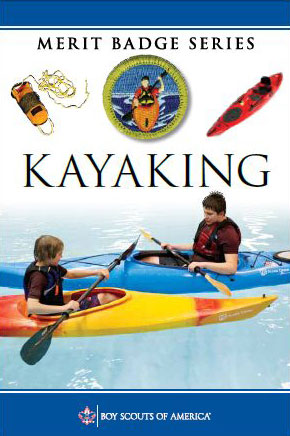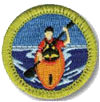- Do the following:
- Explain to your counselor the most likely hazards you may encounter while participating in kayaking activities, including weather and water-related hazards, and what you should do to anticipate, help prevent, mitigate, and respond to these hazards.
- Review prevention, symptoms, and first-aid treatment for the following injuries or illnesses that can occur while kayaking: blisters, cold-water shock and hypothermia, heat-related illnesses, dehydration, sunburn, sprains, and strains.
- Review the BSA Safety Afloat policy. Explain to your counselor how this applies to kayaking activities.
- Before doing requirements 3 through 8, successfully complete the BSA swimmer test: Jump feetfirst into water over the head in depth. Level off and swim 75 yards in a strong manner using one or more of the following strokes: sidestroke, breaststroke, trudgen, or crawl; then swim 25 yards using an easy, resting backstroke. The 100 yards must be completed in one swim without stops and must include at least one sharp turn. After completing the swim, rest by floating.
- Do the following:
- Review the characteristics of life jackets most appropriate for kayaking and why one must always be worn while paddling. Then demonstrate how to select and fit a life jacket for kayaking.
- Review the importance of safety equipment such as a signal device, extra paddle, sponge, bilge pump, rescue sling, flotation bags, and throw bag.
- Do the following:
- Name and point out the major parts of a kayak.
- Review the differences in the design between recreational, whitewater, and sea or touring kayaks. Include how length, width, stability, and rocker are involved in the design of each type.
- Explain the care, maintenance, and storage of a kayak.
- Discuss the following:
- How to use a kayak paddle
- Parts of a paddle.
- The care and maintenance of a paddle
- Using a properly equipped kayak with an open cockpit, a sit-on-top,
or an inflatable kayak, do the following:
- Safely capsize and perform a wet exit.
- Reenter the kayak with assistance from a buddy boat.
- Demonstrate a kayak-over-kayak rescue.
- Demonstrate the HELP position.
- Capsize the kayak, swim it, and then paddle to shore, and empty water from the kayak with assistance if needed.
- As a solo paddler, use a properly equipped kayak to demonstrate
the following:
- Forward stroke
- Reverse stroke
- Forward sweep
- Reverse sweep
- Draw stroke
- Stern draw
- As a solo paddler, use a properly equipped kayak to demonstrate
the following:
- Paddle a straight line for 15 to 20 boat lengths using appropriate strokes while maintaining trim and balance of the kayak.
- Spin or pivot from a stationary position 180 degrees (half circle) to the right and left within two boat lengths.
- Move abeam to the right 10 feet and to the left 10 feet.
- Stop the boat in one boat length.
- While maintaining forward motion, turn the kayak 90 degrees to the right and left.
- Move the kayak backward three to four boat lengths using appropriate and effective reverse strokes
- Paddle the kayak in a buoyed figure 8 course around markers three to four boat lengths apart.
NOTE TO SCOUTS:
This merit badge can be earned concurrently with the Kayaking BSA Award but earning one does not automatically qualify the Scout as earning the other.
The Worksheets below contain contain information on, and can be used for, either or both the Kayaking Merit Badge and the Kayaking BSA award, and indicate which requirements correspond in whole or in part to requirements for the other award.
Note to the Merit Badge Counselor:
In the 2021 Guide to Advancement (BSA Publication 33088 - SKU 648216), Under Section 7.0.1.0 Merit Badge Counseling Risk Management and Quality Control - Section 7.0.1.1 Supervisory Qualifications and Certifications has specific special qualifications or certifications for either the merit badge counselor or the supervisor of certain activities that may be involved with this merit badge, as follows:
The qualifications below for aquatics-related merit badge counseling and supervision not only assist in managing risk, but also give counselors credibility. Current policies are found at Guide to Safe Scouting at www.scouting.org/ health-and-safety/gss/gss02 and supersede any other publications or literature.
Kayaking. Those supervising kayaking activities must have formal training in kayaking and paddle craft Instruction, evidenced by either BSA Aquatics Instructor or Paddle Craft Safety Instructor certification, or kayaking Instructor certification from the American Canoe Association, British Canoe Union, or American Red Cross, or equivalent; OR local councils may approve individuals previously certified as such or trained by an instructor so qualified.
NOTE TO COUNSELORS:
It is permissible for councils to "raise the bar" and approve only those counselors who meet certain qualifications - but this is strictly a council-based decision. It is also permissible, of course, for the National Council or a local council to establish standards for camps or events offering merit badges that include activities requiring special qualifications.
Kayaking instruction should follow the information and techniques presented in this pamphlet. Supplemental information and additional strokes should not be introduced until the basic requirements are met. The learning objectives emphasize safety and basic skills proficiency for solo kayaking. Participants in kayaking instruction should understand and appreciate the limits of their ability and experience. It is the merit badge counselor’s responsibility to follow all BSA safety policies, especially the nine points of Safety Afloat. Although earning the Kayaking merit badge can help prepare a Scout for paddling on moving water, it does not constitute the special training required to participate in a whitewater activity. This merit badge can be earned concurrently with the Kayaking BSA Award but earning one does not automatically qualify the Scout as earning the other.
Teaching Conditions and Equipment
This merit badge should be taught on quiet water without significant wind, waves, or current. The boats should be hard-shell kayaks with large, open cockpits from which the Scout can easily perform a wet exit, or they should be sit-on-tops or inflatable crafts. The boats should preferably be solo boats, and all testing should be done with the Scout as a solo paddler. A kayak with a spray skirt should be permitted only when the Scout has had prior kayak training and is able to perform a wet exit with a skirt to the counselor's satisfaction.
BSA Advancement ID#:
149
Scoutbook ID#:
136
Requirements last updated in:
2020
Pamphlet Publication Number:
35702
Pamphlet Stock (SKU) Number:
650732
Pamphlet Revision Date:
2019
|
|||||||
Page updated on: May 08, 2022









